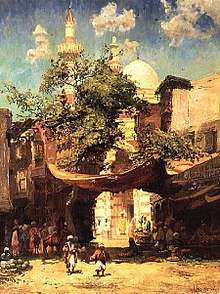Cesare Biseo
Cesare Biseo (April 18, 1843 – January 25, 1909) was an Italian painter known mainly for his orientalist themes.
Cesare Biseo | |
|---|---|
 An Arab Market, by Cesare Biseo | |
| Born | April 18, 1843 Rome, Italy |
| Died | January 25, 1909 Rome, Italy |
| Nationality | Italian |
| Known for | Painter, author |
Biography
He was born in Rome to a family originally from Brescia. He trained under his father. He initially worked in decorative paintings of houses. Biseo was invited by the Viceroy of Egypt to Alexandria, Egypt, to decorate his palace. This trip gave him subjects for future works as painter. He returned to the Muslim world; for example, in the company of Stefano Ussi and Edmondo De Amicis. They were part of the first embassy to Morocco.[1] With De Amicis, Biseo published a book on observations in Morocco and Costantinople, edited by the brothers Treves of Milan. In the 1887 Mostra di Venezia, he exhibited watercolors titled: Ricordi de Cairo.[2]
He also illustrated an 1882 edition of Constantinople by Edmondo de Amicis. Alberto Brambilla of Sorbonne University wrote that this edition "will help shape the European imagination towards Istanbul, and the Orient in general."[3]
Work
Illustrations
-New_Picture_(42).png) Dolap, drawing by Biseo from De Amicis' Constantinople (1882 edition)
Dolap, drawing by Biseo from De Amicis' Constantinople (1882 edition)-Georgian.png) Georgian Woman, by Biseo from De Amicis' Constantinople (1882 edition)
Georgian Woman, by Biseo from De Amicis' Constantinople (1882 edition)
Select list of paintings
- Camel Driver in the Desert, 1870
- Offering at the Zakat, 1870
- Impressions of Cairo, 1870
- Street in an Arab City, 1870
- Favourites in the Park, 1870
- Oriental Dancer, 1876 (oil on panel, 35 x 25 cm)
- The Hookah Smoker, date unknown
Paintings
 Oriental Dancer, 1876
Oriental Dancer, 1876 Outside Cairo, c. 1870
Outside Cairo, c. 1870 A Bedouin Caravan at the Feet of the Sphinx, date unknown
A Bedouin Caravan at the Feet of the Sphinx, date unknown Una giovane marocchina, [A Young Moroccan Girl], 1881
Una giovane marocchina, [A Young Moroccan Girl], 1881
See also
References
- Gli Orientalisti exhibition.
- Dizionario degli Artisti Italiani Viventi: pittori, scultori, e Architetti., by Angelo de Gubernatis. Tipe dei Successori Le Monnier, 1889, page 59.
- Brambilla, Alberto (2018). ""La fata dei mille amanti": Appunti su Costantinopoli di Edmondo De Amicis" [“The fairy of a thousand lovers”: Notes on Constantinople by Edmondo De Amicis]. Litera: Journal of Language, Literature and Culture Studies (in Italian). Istanbul University Press. pp. 185–200. doi:10.26650/LITERA48271. - The document includes an extended English abstract. CITED: p. 185.
| Wikimedia Commons has media related to Cesare Biseo. |